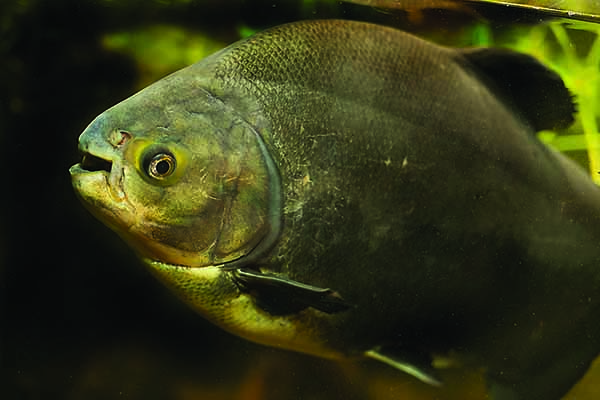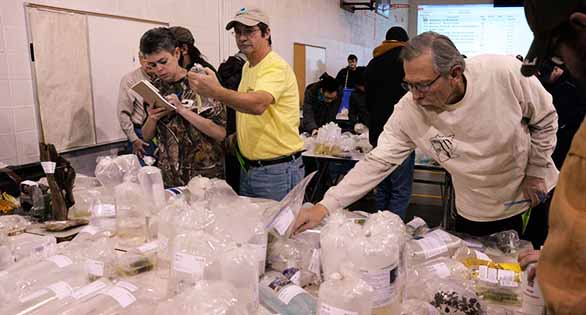
Notorious for outgrowing home aquariums, pet Pacu are too often turned loose in local waters to die, and have drawn criticism to the aquarium hobby.
The Minnesota Aquarium Society and Minnesota Sea Grant host their first-ever Habitattitude Surrender Collaborative
By Stephan M. Tanner, Ph.D.
Preamble
Sometime in late summer 2015, Marte Kitson, M.S., Aquatic Invasive Species (AIS) Extension Educator at the Minnesota Sea Grant Program, contacted me about participating in the Habitattitude Surrender Collaborative. This is a group of aquarium societies, hobbyists, water gardeners, and other aquatic pet- and plant-related groups that promote responsible pet ownership. After a flurry of late-night emails among Minnesota Aquarium Society (MAS) board members, President Brad Swanson (on behalf of MAS) submitted an official letter of support for the program to Doug Jensen, MS.Ed., Aquatic Invasive Species Program Coordinator of the University of Minnesota Sea Grant Program.

A gangbusters turnout rewarded organizers of Minnesota’s first Surrender event in early 2016. More than 100 unwanted animals were re-homed and prevented from being destroyed or turned loose in the wild.
The Problem: Aquatic Life Released Into Nature
What is the gist of the inspiration behind the Habitattitude Surrender Collaborative?
Unfortunately, some misguided folks in our fantastic hobby purchase fish, plants, and other aquatic critters that eventually become surplus because of changing interests, moving, lack of knowledge, outgrowing their aquarium, etc. Regardless of reasons, they may end up being released into the wild like unwanted cats and dogs. Needless to say, as with our furry pets, that is far from ideal, and in many cases downright cruel, because our local habitats do not fulfill the requirements for most aquarium animals.
Moreover—and that is the crucial motivation behind the program—these unwanted animals and plants could become invasive or transmit diseases to our local fauna and flora. While people may think they are doing the kind and right thing by releasing their pets into the environment, it is not a good choice. In the best-case scenario, the animals die. In the worst-case scenario, the fish may physically harm other organisms, spread disease to our native fauna, or, if it finds mates, it may become invasive. This is particularly true for some cool-water species, such as goldfish and koi.
So why do I feel so strongly about this issue? Regardless of what reason leads to (intentional) release of non-native species into our environment, it reflects poorly on us as hobbyists. Whenever you are part of a group with distinct interests, the rest of the world (non-aquarists—yes, they exist!) thinks of you as a group, justified or not. Sure, you can argue that there are always a few black sheep or ignorant individuals, and most of us would never want to harm our native habitats. However, it is up to us—the organized hobbyists and engaged aquarists—to work in our own circles to prevent such releases. Who else should and could accept that responsibility? The aquatic pet trade? Yes, they can help as well. I will get to that further below. But first and foremost, it is up to us to educate and help so that intentional release does not occur.
The tricky part is that, if this happens and leads to environmental or economic harm, then sooner (not later), someone will want or need to curtail our hobby. Even if the majority of us are responsible and keep non-natives out of our ponds, lakes, and sewers, we are guilty by association, whether we like it or not. Our friends in the amphibian hobby were just dealt a hefty blow (see NPR, NYT, and USFWS weblinks), by which the majority of traded or native salamanders, newts, and sirens are now banned from import or interstate transport as injurious wildlife as of January 28, 2016, by an interim rule. Imported Asian salamanders were found transmitting the novel chytrid fungus Batrachochytrium salamandrivorans to wild salamanders in northwestern Europe (Martel et al. 2013, Yap et al. 2015), with outcomes similar to the devastating Batrachochytrium dendrobatidis fungus (Berger et al, 1998) that has led to a massive amphibian species die-off worldwide. Consequently, the justified fear is that if B. salamandrivorans is introduced in North America, some of our native salamanders and newts could face extinction. The interim rule with a public comment period allows time to find a more permanent solution to reduce this risk. Conceivably, the solution could be heavily-regulated imports and specific rules for trade of specimens bred and raised in-country and proven chytrid-free. But let us get back to the fish.
A Solution
From the above follows that the idea of accepting and containing unwanted aquatic life—no questions asked—and trying to re-home them if possible is really a no-brainer. The historic experience is clear: release of non-native species in an environment can have severe consequences. “The good thing about science is that it’s true whether or not you believe in it,” the astrophysicist Neil deGrasse Tyson said during a 2011 interview, and I cannot agree more. Now, some will say most historic introductions have had nothing to do with the most fantastic hobby in the world. But that is not the point. We are not talking about what has already happened, but what could happen in the future, and this is where we come in to prevent it.
Any aquarium or pond fish or plant that is no longer wanted by someone needs to be re-homed or destroyed. Obviously, the former is the preferred method, and we actually have an easy tool at our disposal: most aquarium societies host several fish auctions throughout the year [and we promote these events here at Reef2Rainforest.com – see our Events Calendar – Editor]. Breeders, hobbyists, and enthusiasts come together to trade fish and plants that they have raised at home. Often the array of available species and the health quality is quite high, and people tend to get a great deal on these specimens.
Based on that avenue, MAS agreed to host the first-ever Habitattitude aquarium fish and plant surrender event in collaboration with AIS staff from the Minnesota Sea Grant Program during the spring auction on January 23, 2016. Habitattitude is a national education campaign that promotes responsible aquatic animal ownership by providing suitable alternatives to release. Minnesota Sea Grant was thrilled to collaborate with MAS to host a surrender event and provide just such an alternative. I can honestly say that our people were initially quite skeptical, and it took some convincing that we should be involved. But let us see what actually happened.

An eager crowd inspects incoming livestock at the first Surrender Event in suburban Minneapolis.

A gangbusters turnout for the Minnesota Aquarium Society: unwanted fish are surrendered and “re-homed” by event organizers.
The Experience
Some 35 lots of fish were brought in and surrendered to MAS and AIS people. One lesson they learned was that bags, rubber bands, and labels are needed to repack these fish, since many donors are not necessarily “fish people” who know how to properly bag the animals; some came in containers that the donors wanted back. Luckily, Jen Knutson and Teresa Seaberg stepped up (thank you!) and got everything in shape, registered, and ready for auction. And they did sell. Vice President Andy Jameson reported “…every animal surrendered was purchased by someone at the auction with the lone exception of a goldfish with a large tumor, which needed to be euthanized.” I say that beats a ride down the toilette.
Andy continues, “There were no plants, but a few of the fish also came with small tanks and/or food, and other dry goods. Goldfish predominated, but cichlids, common plecos, platies, and even a Sun Catfish (Horabagrus brachysoma) appeared. There was no count of the actual number of fish, but it was easily over 100.”
Given the average lot price at auction, the surrender donated some $300 to MAS (this money is used for speakers, room rent, and education programs), re-homed over 100 fish, unburdened individuals from animals that they did not want any longer, and removed the risk of release into the wild or an unpleasant death. But it gets better, and that is where this collaboration really helps all sides involved.
Here is Andy again: “I can’t say if the publicity around the surrender event had anything to do with it, but myself and a few others I talked to felt that we had the biggest crowd at auction start that any of us could remember. Regardless of that though, I think the publicity can only be good for our club and our hobby, and the fact that we helped re-home over 100 animals makes it a great success, in my opinion. I very much hope that we can continue this partnership with Sea Grant.”
Moreover, no fewer than three TV stations sent crews to the event! Thus, MAS experienced one of its best public relations events, fulfilled its civic duty as a non-profit, and showed “excellence in fishkeeping.” A win for the animals, the environment, the hobby community, and the unburdened patrons. Who sees a downside?
The “Minnesota experiment” shows that such surrender events are something every responsible aquarium society should offer once or twice a year. Since the Habitattitude program is a national initiative (www.habitattitude.net), support from the Great Lakes Sea Grant network or other programs may be available.
Prevention
Luckily, there was no two-foot Tiger Shovelnose or 10-lb. Pacu to re-home. Such giants cannot be properly kept by most hobbyists, and they have the problem that, aside of getting large, they live to respectable ages of 20 years and more. I already mentioned that the pet trade bears some responsibility. I can quickly come up with a list of common species that simply should not be sold by the mainstream trade (big box retailers, pet store chains, and garden centers). There are specific reasons I mention these retailers as opposed to specialist shops: because they target the beginner audience with almost no experience, and they usually lack trained staff to advise customers on the needs of species that virtually always outgrow their tanks.
These unfortunate fishes include such species such as the Tiger Shovelnose (Pseudoplatystoma spp.) and Redtail Cats (Phractocephalus hemioliopterus), including their hybrids; also Pacus, Common Plecos (Pterygoplichthys pardalis), Pangasius spp. shark catfishes; but also Koi and Goldfish, and a quite few more. While these fish are very cute and cheap when small, these are not beginner fish, and I specifically include goldfish here! They will quickly outgrow any 10- or 20-gallon beginner aquarium.
What is most puzzling to me is, why in the world would you knowingly destroy your customer base? The dumbest thing any business can do is sell a product that almost guarantees that the customer’s experience will have a sad ending! When they bring home such a fish, the first thing it does is dig up the plants or eat all the cute red and blue fishies they already had. They may not have told the employee about them, but they were also not asked what their aquarium looked like. The fish eventually dies because the small tank cannot handle its churning metabolism, since these babies have a healthy appetite and kids love to feed the little gulpers. On the other hand, it may make it, gets way too big, and then what?
Take it to the Zoo? Why Public Aquariums Cannot Accept Your Unwanted Fish
Public aquariums cannot accept unwanted fish for reasons as outlined by Jay Hemdal, my AMAZONAS colleague and curator of fishes at the Toledo Zoo Aquarium.
“The majority of public aquariums in North America are members of the Association of Zoos and Aquariums. As such, they all utilize a process known as ‘collection planning.’ A comprehensive, well-conceived collection plan aids public aquarium curators in maximizing the power their animal collections have to inspire their visitors, enhance conservation efforts, and minimize the number of surplus animals. While collection plans are dynamic by design, animals not required by the plan should not be acquired. It turns out that for most public aquariums, fishes unwanted by their hobbyist owners are likely to be surplus to the aquarium’s collection plan as well. Changing a collection plan to accept an unwanted fish from a home aquarist takes vital resources away from other species, including those of conservation concern.”
Sad Endings or a New Beginning
Most of the time, the story of overgrown tropical fish pets ends in someone giving up the hobby because the whole experience was sad, the tank turned green with slimy algae, and some fish have died! How many times have I heard the words, “I once had an aquarium, but they all died…”
However, again our leadership as engaged aquarists can be the key to avoiding this.
1] Aquarium societies and all stakeholders in the aquatic hobby should petition and push the retailers to abandon selling unsuitable aquarium fish! Not only are they destroying their own customer base, but they are also ruining a good portion of our next generation of upcoming hobbyists.
2] Moreover, the political fallout of selling fish that have a high likelihood of ending up in rivers, lakes, and ponds could lead to state or federal trade restrictions that will get us into the situation where the salamander hobby is now. Note that I wrote “will” and not “might.” If a new pathogen appears that wipes out native fish or species with high aquaculture value that can be traced back to the aquarium fish trade, then the aquarium fish hobby will very quickly run into a wall. Our lobby cannot compete with aquaculture or environmental organizations. You might counter that “pathogens could as easily hitchhike on a 1-inch fish.” Sure, but that fish has a much smaller chance of being released compared to these giants.
There are suitable alternatives to Pacus that do not grow as large, such as Striped Silver Dollars (Metynnis fasciatus) and smaller shovelnose catfishes such as Sorubim lima. While the latter still reaches 20 inches (50 cm), its rather calm attitude makes it a much better aquarium fish than the giant migratory Pseudoplatystoma. Needless to say, neither species is a beginner fish.
Trade Bans?
So should we regulate these “unsuitable species” with laws? Besides the fact that it is complicated, costly, and controversial, my initial gut feeling was that trade prohibitions may not be the best remedy, because they have all kinds of unwanted side effects, such as the development of black markets or elimination of gainful employment in the countries of origin. However, after conversing with my colleague Ret Talbot, senior editor of CORAL magazine, I was persuaded that as a last resort, we should support legislation that would outlaw unsuitable species if the trade was not willing to help solve the problem voluntarily.
With our combined knowledge, we who have been in the aquarium trade for years are in the unique position to make the best recommendations as far as species selection is concerned. If we stick our proverbial head in the sand, then someone else will choose for us—I almost guarantee with an outcome we find even more unsettling. Moreover, we should support heavy-handed prosecution of law-breaking black sheep in the trade. If not, we will all face the consequences, as outlined above.
I want to keep breeding my plecos, tetras, livebearers, and barbs, and keep looking for interesting new fish in the trade. But if some unreasonable and irresponsible trade with a few rather unsuitable species leads to indiscriminate restriction of my favorite hobby, then I am all for kicking them to the curb, both for the sake of the environment as well as the future of our hobby. As with almost any situation, there is no black and white, but in the continuum of gray, there is a region that is plain unreasonable and irresponsible. Regulations that help safeguard our hobby and our environment need not be mutually exclusive.
As animal lovers, we owe that to the generations to come. We will never completely eliminate all risks, but there is a difference between driving down the highway with eyes wide open vs. eyes shut. And right now, the writing is on the wall. Let us not drive into it blindly!
About the Author
Stephan M. Tanner, Ph.D. is a Senior Editor of AMAZONAS and MAS program chair. He lives in Rochester, MN.
Weblinks
Minnesota Aquarium Society (MAS): http://aquarium.mn/
AIS: http://www.seagrant.umn.edu/ais/index
USFWS: http://www.fws.gov/injuriouswildlife/salamanders.html
References
Berger L, Speare R, Daszak P, et al. 1998. Chytridiomycosis causes amphibian mortality associated with population declines in the rain forests of Australia and Central America. Proceedings of the National Academy of Sciences of the United States of America 95(15):9031-9036.
Martel A, Spitzen-van der Sluijs A, Blooi M, et al. 2013. Batrachochytrium salamandrivorans sp. nov. causes lethal chytridiomycosis in amphibians. Proceedings of the National Academy of Sciences of the United States of America 110(38):15325-15329. doi:10.1073/pnas.1307356110.
Yap TA, S. Koo MS, Ambrose RF, Wake DB, and Vredenburg VT. 2015. Averting a North American biodiversity crisis. SCIENCE 31:481-482
Image Credits:
All photos by Randy Carey





